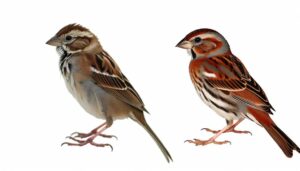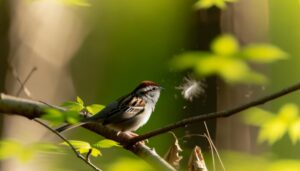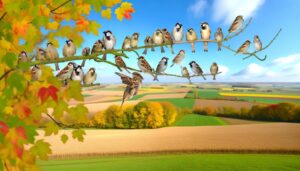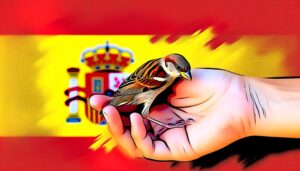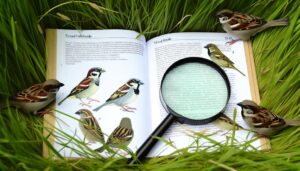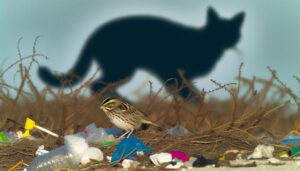Identifying the Golden Crowned Sparrow: Key Facts and Features
The Golden Crowned Sparrow is a North American migratory bird known for its distinctive golden-yellow crown and unique song. This medium-sized member of the New World Sparrow family exhibits a significant wingspan of 22-25 cm along with a round body and a sturdy beak used for seed-husking.
The sparrow's song, a three-note melody likened to 'Oh, dear me,' plays a key part in communication and courtship. Its diet primarily comprises seeds, berries, and insects.
The intricate patterns and behaviors of this fascinating species are intriguing, and there's always more to discover about their migration patterns, lifespan, and role in the ecosystem.
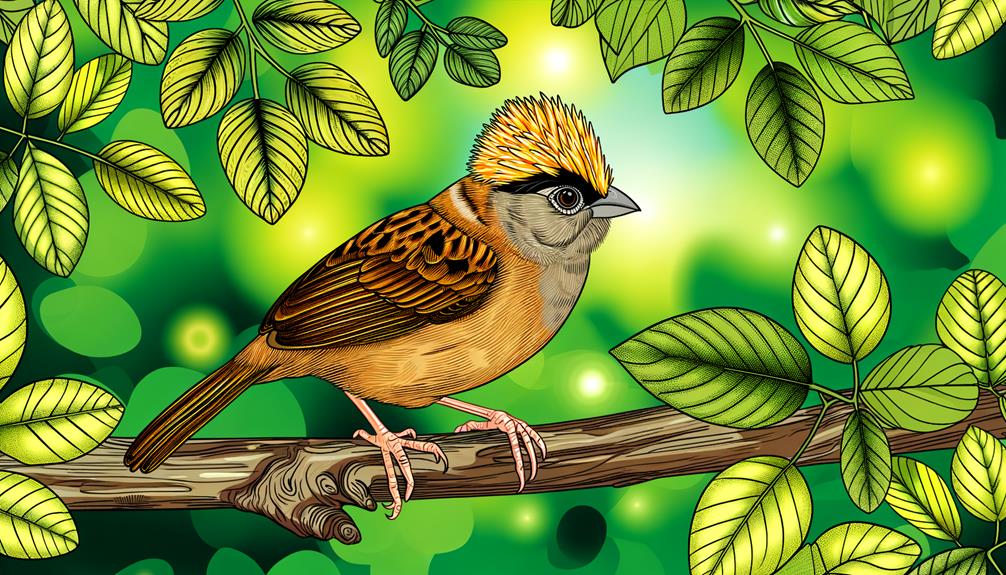
Key Takeaways
- The Golden Crowned Sparrow is a medium-sized bird known for its distinctive golden-yellow crown and three-note song.
- It has a migratory nature, traveling across the western coast of North America from Alaska to California.
- Its diet mainly consists of seeds, berries, and insects, playing a significant role in pest control and plant dispersal.
- Predators such as hawks, owls, and domestic cats pose threats to the sparrow, which uses camouflage and deceptive behaviors for survival.
- The species faces conservation challenges due to habitat loss, climate change, pesticide exposure, and predation by non-native species.
Overview of the Golden Crowned Sparrow
Often seen during the fall migration, the Golden Crowned Sparrow is a medium-sized bird renowned for its distinctive golden-yellow crown and melodious song. This avian species, hailing from the New World Sparrow family, exhibits intriguing migratory habits, primarily across North America. It's known for its striking presence in the Pacific Coast, especially Alaska and British Columbia, during summer breeding periods.
As temperatures drop, they migrate south to California, staying till spring. Their distinct song, likened to a three-note melancholic whistle, has been noted by ornithologists and bird watchers alike. Their diet comprises mainly seeds, berries, and insects. These birds have a social disposition, often seen in flocks during non-breeding seasons.
This overview provides a glimpse into the fascinating life of the Golden Crowned Sparrow.
Unique Physical Characteristics
One of the most striking features of the Golden Crowned Sparrow is its distinctive feather markings, particularly the bright, yellow patches that adorn its crown.
These birds also possess a certain uniformity in size and shape, with dimensions that set them apart from other sparrow species.
A detailed analysis of these unique physical characteristics not only provides insight into their identification and taxonomy, but also reveals fascinating aspects of their adaptation and survival strategies.
Distinctive Feather Markings
The Golden Crowned Sparrow boasts a distinctive feather pattern, characterized by its namesake golden crown, which sets it apart from other sparrow species. This remarkable feature is most vibrant in adult specimens, particularly males, during the breeding season. The crown's golden hue contrasts sharply with the bird's otherwise dull, grey-brown plumage, accentuating the bird's visual appeal.
The feathers also exhibit subtle variations in color, with the back and wings showing a mix of brown and grey, while the underparts display a lighter shade. The flanks carry a hint of olive-brown, adding to the bird's unique aesthetic.
These markings aren't merely ornamental; they serve functional purposes, including camouflage and mate attraction. Understanding these distinctive feather markings provides a deeper appreciation of this remarkable sparrow species.
Sparrow's Size and Shape
Despite its impressive feather markings, it's the Golden Crowned Sparrow's size and shape that truly distinguish it from other species in the bird kingdom. The bird's robust physique, measuring between 15-17 cm in length, sets it apart. It possesses a round body, with a large, rounded head that's accentuated by the golden crown.
The wingspan is a substantial 22-25 cm, indicative of the bird's strong flight capabilities. The beak, a crucial organ for its survival, is conical and sturdy, designed for efficient seed-husking. The tail, a key element in flight and balance, is moderately long and slightly forked.
Essentially, the Golden Crowned Sparrow's unique form is an amalgamation of evolutionary adaptations, each serving a specific purpose to ensure its survival.
The Sparrow's Distinctive Song
Echoing through North America's western coast, the Golden Crowned Sparrow's song stands out with its melancholic, three-note melody that's been likened to a poignant phrase, 'Oh, dear me.'
This distinctive song, an acoustic signal, is primarily used for communication, especially during courtship and territorial disputes. The song's pitch, volume, and duration can change as per the bird's specific needs.
The song is a learned behavior, passed down from adult males to juvenile sparrows during summer months. Moreover, while all Golden Crowned Sparrows share the same basic melody, each bird's song is unique, with slight variations in rhythm and pitch.
This individual signature allows sparrows to identify each other, proving essential for social interactions within the species.
Geographical Distribution and Habitat
Often found along the western coast of North America, Golden Crowned Sparrows inhabit a range of environments, from shrubby areas and thickets to forests and tundra during their breeding season. Their geographical distribution extends from Alaska down to California, spanning a significant latitudinal gradient.
They've adapted to various habitats, displaying remarkable habitat plasticity. In the breeding season, they're known to favor scrubby tundra-like habitats and open boreal forests. In contrast, during the non-breeding season, they inhabit a variety of habitats such as coastal scrublands, gardens, and urban areas.
Their chosen habitats are generally characterized by ample cover, rich in food resources like berries, seeds, and insects. Understanding this distribution and habitat preference is key to their conservation efforts.
Golden Crowned Sparrow Migration Patterns
While they're known for their geographic flexibility, Golden Crowned Sparrows exhibit a consistent migration pattern, traveling between their breeding grounds in Alaska and Canada to their winter habitats in the Pacific Coast, showcasing a remarkable example of avian long-distance migration.
These sparrows' journey is typically initiated by changes in daylight length, triggering an instinctual response to migrate. They utilize a multitude of environmental cues, such as magnetic fields and celestial bodies, for navigation.
This cyclical movement is crucial for their survival, as it allows them to exploit seasonally abundant resources. Notably, first-year birds undertake this arduous journey without guidance, indicating a genetically ingrained migration pattern.
Understanding these migration patterns is crucial to conserving this species' habitats.
Nesting Habits Explored
Just as the Golden Crowned Sparrow's migration habits are remarkably predictable, so too are their nesting patterns, which provide fascinating insights into their life cycle and reproductive behaviors.
These sparrows typically construct their nests in low shrubs or on the ground, using a variety of materials including grasses, moss, and bark. The nests are usually lined with finer materials, such as feathers or hair, for added comfort and insulation.
Females lay between 3 to 5 eggs per clutch, with an incubation period of approximately 12 days. Both parents share responsibilities of incubating the eggs and feeding the hatchlings.
The young sparrows fledge after about 9 to 12 days, yet they continue to rely on their parents for food and protection until they're fully independent.
Diet and Feeding Behavior
The Golden Crowned Sparrow's diet primarily comprises seeds, berries, and insects, which they skillfully forage from the ground and low-lying shrubs. Their feeding behavior is characterized by a keen attention to detail, meticulously searching through leaf litter and undergrowth for nourishment.
They're known to display seasonality in their diet, with a higher intake of insects during the breeding season to support energy-intensive activities like nesting and feeding young ones. During winter, they shift towards a seed-based diet, as insect availability dwindles. They've also been observed consuming flower buds and new growth, particularly in spring.
This dietary flexibility allows them to exploit diverse food resources and adapt to fluctuating environmental conditions, ensuring their survival.
Predators and Survival Strategies
The Golden Crowned Sparrow faces various threats in its natural habitat, with the most significant predators being hawks, cats, and snakes. These birds have developed a range of survival strategies to evade these dangers, which showcase both their adaptability and the evolutionary pressures placed upon them.
This section will provide a thorough examination of these predators and survival techniques, offering an analytical insight into the sparrow's behavioral responses and survival mechanisms.
Notable Predators
While golden crowned sparrows are skilled in flying and hiding, they're often targeted by various predators such as hawks, owls, and domestic cats. Hawks, known for their exceptional vision and swift, powerful flying abilities, capture sparrows either in mid-air or while they're perched.
Owls, hunters that are active during the night, take advantage of the sparrows' vulnerability in darkness using their noiseless flight and sharp claws. Domestic cats, though not natural predators, can pose a significant danger, especially in urban areas. They're sneaky, fast, and proficient at ambushing unsuspecting birds.
Each predator employs a unique approach that makes survival a challenge for these sparrows. It should be noted that predation rates can vary depending on factors like location, weather conditions, and the availability of protective shelter.
Survival Techniques
Despite facing a myriad of predators, golden crowned sparrows have evolved a variety of survival strategies, which they deftly employ to evade capture and safeguard their existence.
Their distinct, olive-brown plumage blends seamlessly with the ground and vegetation, providing effective camouflage. When threatened, they employ a 'freeze' strategy, remaining motionless to avoid detection.
In addition, their sharp, piercing calls alert other sparrows of impending danger, fostering a communal defense system. They've also been observed engaging in deceptive behaviors, such as false nesting, to mislead predators.
Intriguingly, their migratory nature also serves as a survival strategy by reducing exposure to localized threats. These adaptations, coupled with their keen vigilance, secure the golden crowned sparrow's survival in the face of adversity.
Lifespan and Reproduction Cycle
Golden Crowned Sparrows typically enjoy a lifespan of up to 6 years, showcasing intriguing patterns in their reproduction cycle that's worth a detailed exploration. Remarkably, their mating and reproduction habits are closely tied to their migratory patterns.
- Spring Initiation: They begin courtship during the spring migration, males employing melodious songs to attract females.
- Nesting: Females construct nests in low shrubs or on the ground, laying about 2-5 eggs.
- Incubation: The female incubates the eggs for 11-14 days before the chicks hatch.
- Fledgling Phase: After about 9-12 days, the hatchlings, now fledglings, leave the nest, yet parents continue to feed them for another two weeks.
These stages reflect nature's incredible orchestration, enchanting those keen to understand the mysterious rhythms of avian life.
Role in Ecosystem and Impact
The Golden Crowned Sparrow plays a pivotal role in its ecosystem with specific contributions that warrant scientific analysis.
Its impact on the environment, both potentially beneficial and detrimental, is a matter of considerable ecological interest.
A careful examination of these aspects will shed light on the intricate balance between this species and its habitat.
Ecosystem Contributions
Serving as an important link in the food chain, golden crowned sparrows contribute greatly to their ecosystem by consuming a variety of insects and seeds, thereby aiding in pest control and plant dispersal.
Through their feeding habits, these birds contribute to:
- *Insect control:* Sparrows consume a large number of insects, mitigating the impact of potential pests on plant life.
- *Seed dispersal:* The birds ingest seeds and disperse them through their droppings, aiding in plant proliferation.
- *Soil fertilization:* Their droppings enrich the soil, which can improve the health of the ecosystem.
- *Prey role:* Sparrows serve as a food source for predatory species, helping maintain balance in the food chain.
Their overall contributions underline the importance of their conservation for the sustainability of their habitats.
Environmental Impact
In an ecological context, golden crowned sparrows play an essential role not only as consumers, but also as agents of seed dispersal and soil enrichment, thereby profoundly impacting their environment. Their diet primarily consists of seeds, insects, and berries, which they disperse throughout their habitat, inadvertently promoting plant growth and diversity.
Their excretions enrich the soil by adding organic matter and nutrients, enhancing the overall soil health. Additionally, they serve as prey for various predators, maintaining the balance of the food chain. However, changes in their population due to habitat loss or climate change could upset these ecological processes.
Therefore, the golden crowned sparrow's existence is intrinsically tied to the health of its ecosystem, highlighting the importance of its conservation.
Conservation Status and Threats
Despite their seemingly abundant presence, Golden Crowned Sparrows face several threats that could potentially impact their conservation status. These include:
- Habitat Loss:
Rapid urbanization and agricultural expansion are encroaching on their natural habitats, leading to displacement and population fragmentation.
- Climate Change:
Rising temperatures and erratic weather patterns can disrupt their migratory cycles, breeding patterns, and food availability.
- Pesticide Exposure:
The use of toxic chemicals in agriculture can contaminate their food sources, leading to health complications and increased mortality rates.
- Predation:
Increased predation by domestic cats and other non-native species is a growing concern, especially in urban environments.
Given these threats, adopting thorough conservation strategies is crucial for safeguarding the survival of this unique species.
Notable Golden Crowned Sparrow Observations
Turning our attention away from the threats these birds face, we can now explore some of the most remarkable observations made about the Golden Crowned Sparrow.
Particularly, these sparrows have shown a remarkable consistency in their migratory patterns, returning annually to the same exact location. This behavior, known as site fidelity, showcases their impressive navigational skills.
Additionally, their distinctive, melancholic song has intrigued ornithologists. It's been noted to vary regionally, suggesting a form of 'dialect.'
They've also displayed an interesting feeding behavior called 'gaping' where they open their beaks to dislodge soil and expose insects.
Such observations not only highlight the unique behaviors of the Golden Crowned Sparrow but also their adaptability to their environment.
Conclusion
Simply put, the Golden Crowned Sparrow is an intriguing bird with distinctive physical characteristics and a unique song. Its migration patterns and role within its ecosystem are essential components of biodiversity. Despite encountering threats, their conservation status remains steady.
Additional observations and research are necessary to guarantee their survival, so they can continue to contribute to the grand symphony of nature. Indeed, it's not just another addition to avian diversity.

